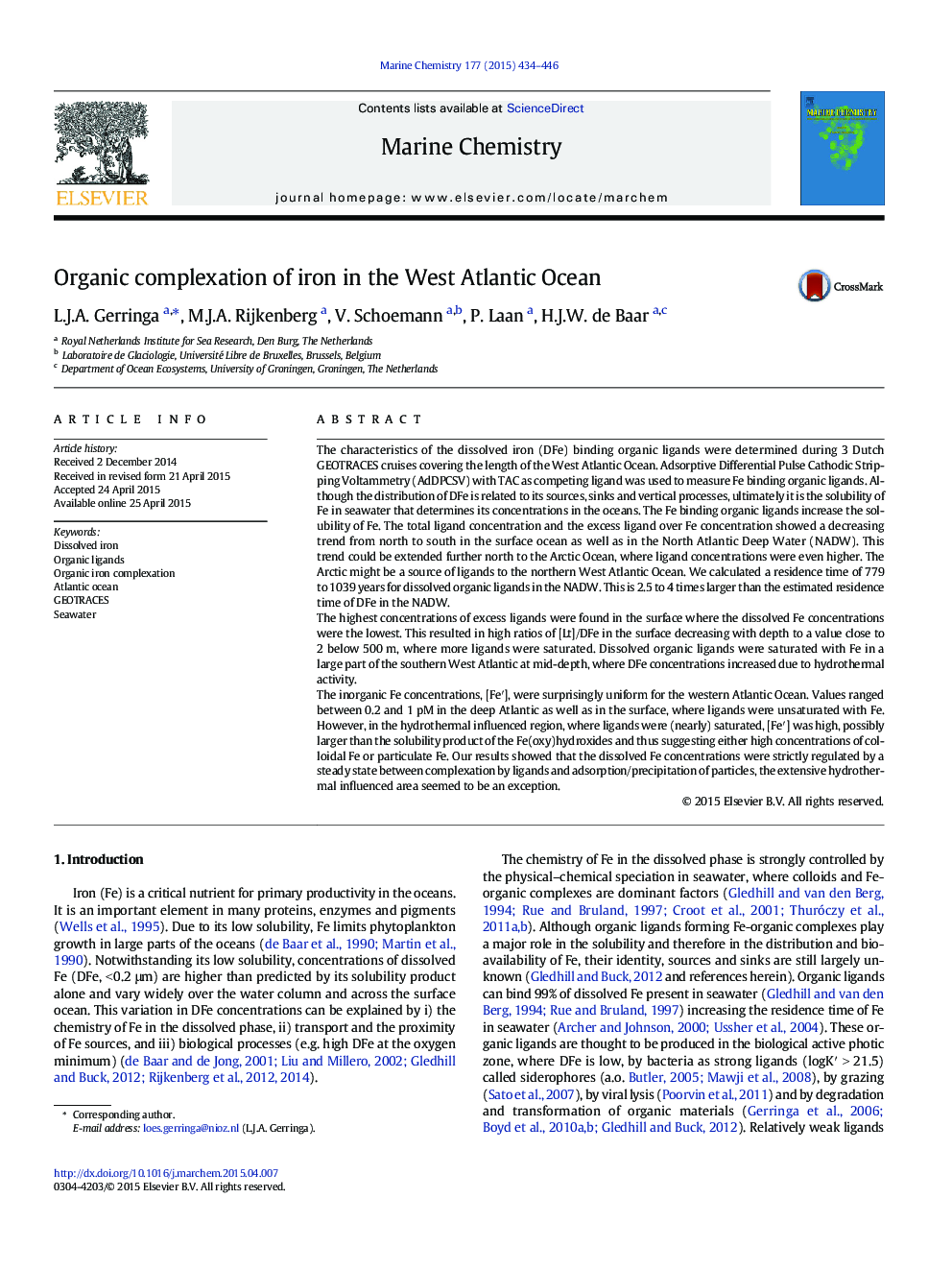| کد مقاله | کد نشریه | سال انتشار | مقاله انگلیسی | نسخه تمام متن |
|---|---|---|---|---|
| 1262712 | 971889 | 2015 | 13 صفحه PDF | دانلود رایگان |
• The total ligand concentration ([Lt]) in the western Atlantic Ocean is high in the north and decreases from the Arctic Ocean to the south. Within the NADW, [Lt] decreases linearly with distance from north to south coinciding with a decrease in DOC (Hansell et al., 2009) and therefore probably due to mineralisation of the organic ligands
• In the Southern Hemisphere between the equator and 30°S at a depth of 1000 to 3000 m, ligands were (nearly) saturated with Fe resulting from hydrothermal activity as also observed by Buck et al.(2014) near the Mid Atlantic Ridge in the North Atlantic Ocean. Apart from the distinct Fe sources as the hydrothermal source and remineralization in the oxygen minimum zone, calculated [Fe′] is very uniform between 0.2 and 1 pM confirming that a tight equilibrium exists between ligands and scavenging particles.
• Our study shows that the concentration of labile DFe in the NADW increases during southward transport, because more iron is added than ligands.
The characteristics of the dissolved iron (DFe) binding organic ligands were determined during 3 Dutch GEOTRACES cruises covering the length of the West Atlantic Ocean. Adsorptive Differential Pulse Cathodic Stripping Voltammetry (AdDPCSV) with TAC as competing ligand was used to measure Fe binding organic ligands. Although the distribution of DFe is related to its sources, sinks and vertical processes, ultimately it is the solubility of Fe in seawater that determines its concentrations in the oceans. The Fe binding organic ligands increase the solubility of Fe. The total ligand concentration and the excess ligand over Fe concentration showed a decreasing trend from north to south in the surface ocean as well as in the North Atlantic Deep Water (NADW). This trend could be extended further north to the Arctic Ocean, where ligand concentrations were even higher. The Arctic might be a source of ligands to the northern West Atlantic Ocean. We calculated a residence time of 779 to 1039 years for dissolved organic ligands in the NADW. This is 2.5 to 4 times larger than the estimated residence time of DFe in the NADW.The highest concentrations of excess ligands were found in the surface where the dissolved Fe concentrations were the lowest. This resulted in high ratios of [Lt]/DFe in the surface decreasing with depth to a value close to 2 below 500 m, where more ligands were saturated. Dissolved organic ligands were saturated with Fe in a large part of the southern West Atlantic at mid-depth, where DFe concentrations increased due to hydrothermal activity.The inorganic Fe concentrations, [Fe′], were surprisingly uniform for the western Atlantic Ocean. Values ranged between 0.2 and 1 pM in the deep Atlantic as well as in the surface, where ligands were unsaturated with Fe. However, in the hydrothermal influenced region, where ligands were (nearly) saturated, [Fe′] was high, possibly larger than the solubility product of the Fe(oxy)hydroxides and thus suggesting either high concentrations of colloidal Fe or particulate Fe. Our results showed that the dissolved Fe concentrations were strictly regulated by a steady state between complexation by ligands and adsorption/precipitation of particles, the extensive hydrothermal influenced area seemed to be an exception.
Journal: Marine Chemistry - Volume 177, Part 3, 20 December 2015, Pages 434–446
